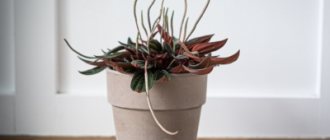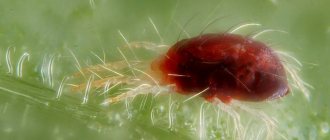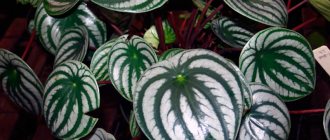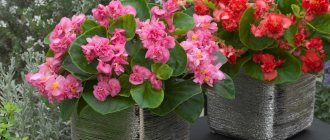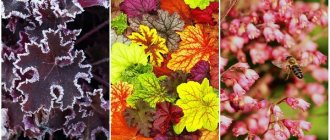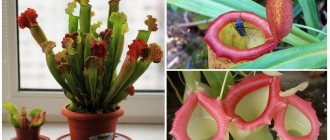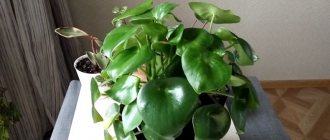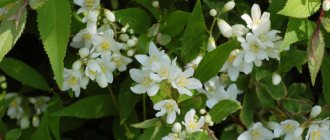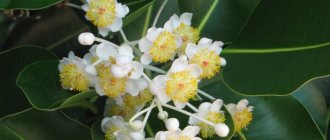The peperomia flower has been very popular among gardeners for many years. An evergreen perennial herbaceous plant belongs to the Pepper family. Peperomia is native to India and South America, and there are more than 1000 species of this amazing flower in the world. Ampel varieties are widely used in the design of balconies and window openings. By placing a plant in a hanging pot, you can significantly transform the room and add originality to the interior. Cut peperomia stems are often used to decorate rooms. Bush species have also managed to take root in offices and apartments. They are quite compact (stems reach a height of 20-30 centimeters), have the shape of a small bush, abundantly covered with colorful foliage. During the flowering period, peperomia will delight you with fragrant buds rising above the foliage. Whatever variety you prefer, before purchasing you should definitely study the information about the features of caring for a tropical wonder, as well as recommendations for its planting, pruning and propagation.
Peperomia - species that accumulate moisture
Peperomia stands out for its thick leaves of original colors.
About 30 species of this plant have been bred. And for all of them, decorativeness lies in the beauty of the foliage, and not in more than modest flowering. Succulent species do not require special care, as they prefer to store all nutrients in case of unfavorable conditions. Therefore, it grows slowly, which helps the plant maintain its decorative appearance. The origin of Peperomia is very exotic. It is native to tropical and subtropical regions of South America. Under natural conditions it grows up to 50 cm, giving all its nutrients to powerful shoots and thick, waxy leaves. This plant is an epiphyte, it nests on the tops of the tallest plants to catch some sunlight. It collects nutrients from humus formed in the large forks of the tree.
Peperomia leaves not only have a rich palette of colors, but also vary greatly in shape between different varieties. Such diversity is difficult to imagine.
Peperomia: brief description and types
The highlight of the different types of this plant is the foliage, which can be small or large, thin or dense, smooth or wrinkled, round or oblong, etc. The color varies from golden and brown to light and dark green. Also, the color can be diluted with spots and streaks of white or yellow.
Blooming peperomia
Flowering occurs in spring and summer. At this time, numerous shoots with very thin, elongated inflorescences of pinkish or cream color rise above the peperomia foliage. Ripe fruits on the surface of the flowers look like small berries, which are very easily separated from the plant.
For your information! Fruit formation is possible only in wild conditions. Pollination occurs with the help of certain types of insects.
The height of the bush can reach from 15 to 50 cm.
In floriculture, peperomia are highly valued for their decorative properties, diversity of species and low maintenance requirements.
Among the numerous forms of peperomia, both erect and branching (which are grown as ampelous) species stand out. Bush-like crops are also found.
Peperomia is characterized by slow growth (the length of the shoots increases by 13 cm annually) and not the most powerful root system, therefore it is often used in flower arrangements (for example, together with citrus fruits or monstera).
The arrangement of petiole leaves is regular.
Flower propagation can be done in three ways:
- cuttings;
- seeds;
- dividing the bush.
Succulent species
Peperomia dolabriformis
A real succulent with very original leaves. They resemble circles folded in half. There are points at the tips. They are attached to a thick trunk, forming a star-shaped rosette. The leaves reach a length of 7 cm, and a width of about 2 cm. A dark green border is formed at the places where the leaves grow together.
The stems are erect, with few branches, reaching a height of 60 cm. But unlike many relatives, it blooms quite gracefully, producing branched inflorescences with small white-greenish flowers.
Peperomia chisel
Peperomia columella (Peperomia columella) - Column
A very interesting species, striking in the uniqueness of its leaves. Many emerald-colored leaves, similar to dragon scales, densely cover the stem. It grows only 20 cm in height, so it is better to plant the flower in groups. When they reach a certain age, the stems begin to bend in an arched manner, and then they can be planted in pots and used as an hanging plant.
Peperomia columella
Peperomia ferreyrae
A striking representative of epiphytic succulent plants. All the beauty lies in the bright green leaves. They seem to have fused in the middle, and the place of this fusion is highlighted in a darker green color. The height of the plant does not exceed 30 cm, and the leaves can grow up to 7-8 cm in length. Since they contain a large amount of moisture, they are very elastic and thick in appearance. The plant loves moist soil, but does not tolerate stagnant water. Be sure to drain excess water from the pan. If the leaves are heavily dusted, you can make a small tropical rain from the shower with warm water, while being careful not to flood the soil substrate.
Peperomia Ferreira
Peperomia graveolens
The modest tropical beauty is one of the succulent species of Peperomia. All the beauty is in the leaves of this plant. Nature has colored them quite bizarrely. The leaves are light green above and ruby or burgundy below. The leaves curl in an arc towards the most upright burgundy trunk. The whole appearance of the plant resembles sea coral, especially when the soil is covered with small sea pebbles. It grows as a small bush, up to 25 cm high. It blooms modestly, with long spikelets with light yellow flowers on long burgundy peduncles.
Peperomia verticillata
A perennial herbaceous plant, evergreen, with ampelous shoots drooping downwards. It has fleshy leaves of a grayish-green color. The whorled form of leaf attachment gives it its corresponding name. This variety is best propagated by cuttings. During the formation of the crown, you can set aside the cut tops for later rooting.
Peperomia whorled
Watering
Watering in the spring-summer period is carried out quite often, as soon as 2-3 cm of the soil substrate has dried. The water should be slightly above room temperature, soft and well purified.
In autumn and winter, watering is reduced and watered only when the entire lump of earth has dried out. The water from the pan must be drained to avoid the occurrence of fungal diseases and mold.
Heavy moisture can lead to rotting and death of the entire plant. Therefore, it is necessary to water carefully and in a timely manner.
Lighting
For Peperomia it is very important to choose a suitable place:
- It should be well lit, but the plant should not be placed in direct sunlight. This will cause burns on the leaves and the succulent will lose its natural appeal.
- The plant should also not be placed in shaded areas without additional artificial lighting. The plant will stretch out, the leaves will become smaller and faded than they should be. This is especially true for variegated forms of Peperomia.
Temperature
This amazing plant practically does not need a winter dormancy period. Peperomia tolerates cold periods well at temperatures not lower than 16 degrees. But even at room temperature the plant feels quite comfortable. In the summer, you can expose Peperomia to fresh air, but not to direct sunlight and avoid harmful drafts. Even a small draft will cause the plant to fall leaves and become diseased. The best place is a closed balcony or a place on the terrace in a place protected from the wind.
Humidity
The fleshy succulent leaves of Peperomia accumulate water well, so there is no point in artificially humidifying the air. However, the plant loves spraying. On hot summer days, you can arrange a small shower, which, in addition to moisturizing, also has hygienic functions: it frees the leaves from dust, since it is difficult to clean the leaves with a sponge. Shower with warm, soft water. Be sure to let the plant dry in the room before taking it out into the fresh air.
The soil
You can use traditional store-bought soil for cacti. You can make your own soil mixture. To do this you need to take in equal parts:
- Garden humus, steamed in the oven;
- leaf soil;
- peat, can be bought at a flower shop;
- coarse river sand, well washed in running water.
Mix all components until smooth, add fine-grained expanded clay, crushed coal and a little zeolite.
Pay special attention to drainage, since Peperomia has a small root system, it is necessary that the drainage occupies 1/3 of the flat pot. Drainage can be made from large expanded clay or broken red brick.
Transfer
The plant is replanted every three years. Peperomia grows quite slowly (meaning succulent species) and there is no need for frequent replanting. Most often, partial replanting is used - change the pot to a wider one, add soil mixture and replace 2-3 cm of old soil on top with fresh mixture.
Succulent species of this plant are perfect for growing in florariums, as they grow slowly and retain their decorative appearance for a long time.
Fertilizer
Fertilize throughout the active growing season. It is enough to buy complex fertilizer for succulents and cacti in the store and apply it according to the instructions along with watering. Fertilizers should be diluted in warm water. And don't overdo it, as strong concentrations can burn the delicate roots of succulent species. With the correct concentration and time of feeding, the colors of the plant become brighter.
Species diversity
In total, 1161 species are registered in the genus Peperomia. Individual plants can differ greatly from each other. In indoor culture, most often there are no more than 1-2 dozen plants.
Peperomia obtufolia. A subshrub with erect, branched shoots covered with reddish skin, it grows a large number of fleshy, rounded leaves up to 12 cm long. The leaves are single-colored and dark green. They have short petioles. A popular ornamental variety is Peperomia variegata. Its leaves with a dark green center are edged with light green or cream uneven stripes. In the center along the veins, thin strokes are noticeable.
Peperomia obtufolia
Peperomia magnoliafolia. The highly branched, erect shoots have a bare reddish surface and are covered with many smooth, fleshy leaves. The obovate leaf blade with a short petiole grows 12-15 cm in length. Green leaves are sometimes covered with yellow or silvery spots.
Peperomia magnoliafolia
Peperomia Lilian. A compact subshrub with beautiful heart-shaped leaves is highly decorative. The surface of the leaf blade between the veins is swollen and may have a contrasting color. The shiny, fleshy leaves grow close together to form a dense bush. At the beginning of summer, dense inflorescences with a thickening at the end appear. They rise above the green mass on long peduncles. The greenish-white or cream inflorescences vaguely resemble lily buds, which is how the species got its name.
Peperomia Lilian
Peperomia clusifolia. The large subshrub is distinguished by erect, fleshy shoots. They bear large, short-petiolate, obovate-shaped leaves. The length of the thick leaves reaches 15 cm. They are dark green in color and have reddish-brown streaks closer to the edge.
Peperomia clusifolia
Peperomia Rosso. The subshrub up to 25 cm high is covered with fleshy leaves. On succulent stems, foliage grows in bunches, close to each other. The plant is famous for its high decorative value due to the spectacular coloring of the leaves. Their surface is painted in a uniform dark green shade. The reverse side has a bright red-burgundy color. In indoor conditions, the variety almost does not bloom.
Peperomia Rosso
Peperomia whorled. The herbaceous perennial is suitable for hanging. Its lodging long stems are covered with medium-sized, fleshy foliage of oval or rhombic shape. Green leaves, practically without petioles, grow in whorls at the nodes. Flowering occurs in June.
Peperomia whorled
Peperomia pereskifolia. The large variety has highly branched shoots. At the beginning of growth, the stems grow straight, but gradually lower under their own weight. The foliage is grouped into whorls of 3-5 pieces. Oval leaves with a blunt edge grow 3-5 cm in length and 2-3 cm in width. Arched veins are visible on the leaf surface. Dark green foliage is covered with pinkish or silvery streaks.
Peperomia pereskifolia
Peperomia capita. The ampelous species grows long, but thin, creeping shoots. They have wide oval, small, bright green leaves.
Peperomia capita
Diseases and pests
Peperomia suffers greatly from low temperatures and stagnant water.
- The root system is quickly susceptible to putrefactive diseases. If the plant is left for a long time in conditions that are not comfortable for it, it may completely die. Signs of the disease are leaf lethargy and falling off . If the rot has not damaged the entire plant, then you can try to save it by cutting out the diseased areas with a sharp knife and sprinkle with ash or crushed coal;
- Also, with high humidity, the plant can be affected by powdery mildew; it is revealed by a light gray coating on the lower part of the leaf. Pests can enter a plant either when they are in the fresh air or when purchased;
- Most often, the plant is affected by spider mites and mealybugs , less often Peperomia is affected by a nematode. These places must be removed with a sharp knife and sprinkled with crushed coal.
Pest and disease control
At low humidity and high temperatures, thrips appear on peperomia leaves. Less commonly, spider mites or mealybugs. The first thing you need to do is wash the plant well with soapy water, increase the air humidity and use indoor insecticides.
A more dangerous enemy is nematodes, which literally penetrate the structure of the plant. They can be seen by dark swellings on the roots. A heavily damaged flower will have to be destroyed, but with minor damage, half an hour in a hot bath and treatment with drugs can save it.
Due to too intense watering, rot of the root collar or roots appears. The plant needs to be washed, damaged areas cut off, sprinkled with coal and replanted. Complex fungicides help well against fungus on leaves and shoots in the early stages.
Photo: biolib.cz
Hatiora (50 photos): types, care and cultivation at home
Reproduction
Propagation by seeds, although it produces many seedlings, requires quite a lot of effort and attention:
- The soil for sowing is made from equal parts of leaf soil and river sand;
- The seeds are very small, so you need to try to distribute them evenly and press them a little into the soil;
- The container is covered with glass or plastic film;
- Place in a well-lit place and regularly spray the crops;
- Suitable temperature is 24-25 degrees. You also need to ventilate the greenhouse from time to time;
- After two true leaves appear, the seedlings are planted in another container with 2 cm gaps between plants. When they are thoroughly strengthened, they are transplanted into separate small pots.
The best method of propagation is cuttings:
- From hanging plants, cuttings with two or three internodes are taken;
- They can be placed in a glass of water;
- When a sufficient number of roots appear, immediately plant them in separate pots.
In other cases, you can propagate Peperomia by dividing the bush when replanting:
- Divide a large, strong bush into 2-3 parts, sprinkle the divisions with crushed coal.
- Plant each part in a suitable pot.
In exceptional cases, if you only get one leaf from a plant you like, don’t be discouraged. You need to shorten the cuttings a little and plant them in a peat-sand mixture, cover them with a plastic bag to create greenhouse conditions. As soon as new shoots emerge from the leaf, you need to plant them in a separate pot.
How to transplant correctly
Regular replanting is recommended every two to three years. To do this you need:
- fill a third of the volume of the new pot with drainage;
- pour a layer of soil mixture and moisten it;
- carefully remove the peperomia along with a lump of earth from the old container;
- lower the plant into a new pot and carefully add the substrate without compacting it;
- To shrink the soil, you need to water the flower well, and then add the rest of the soil; Be sure to drain the water from the pan.
Peperomia: types and varieties, cultivation features
A flower called peperomia - Peperomia (dwarf pepper) - most often a small herbaceous plant with thick leaves of different sizes and shapes, colors and structures. Belongs to the Piperaceae (Pepper) family. The homeland is considered to be Tropical America and Asia. The name translated from Greek means: “peperi” - “pepper” and “omos” - “same”. In nature, it can grow on bushes and tree bark, rotting parts of plants, in forests on soils rich in peat, and less often on rocky terrain. Popular names such as “pepper-like” or “plant with a rat’s tail” are common.
It can grow as a shrub, subshrub and sometimes as a hanging crop. Due to this, it is widely used at exhibitions and in floral compositions. The flower is rich in an abundance of shapes and shades, which makes it a welcome guest not only in homes, but also in botanical gardens. Thanks to its wide variety of species, it often serves as the basis for flower arrangements, and variegated varieties often play the role of bright additions and color accents.
Peperomia at flowering time
During flowering, peperomia produces numerous spikelet-shaped inflorescences, somewhat similar in appearance to the color of plantain, and inconspicuous small flowers. This is where the name “rat tail plant” comes from. The inflorescence reaches a length of 6-7 cm and is a thin, slightly twisted or bent process. Flowering usually occurs in spring or summer. The appearance of the flowers varies depending on the species and variety. Some flowering species have fragrant inflorescences. At the end of the flowering period, fruits are formed, which are presented in the form of small dry berries, very easily separated from the “cob”.
A photo of a blooming indoor peperomia is offered below for your reference - appreciate the extraordinary nature of the green “pet”:
A beautiful crop for collectors, especially for those who have limited space for plant placement. In addition, it is quite unpretentious, which makes the process of growing it simple. Home indoor peperomia flowers reach a height of 50-55 cm, dwarf varieties - up to 15-20 cm. The plant is distinguished by its great species diversity. The leathery, shiny leaves can be different shades of green and have all sorts of shapes - from small and thin to fleshy and wide with a curled end. The dense, fleshy stems of tall plants can bend under their own weight as they grow.
An interesting feature of this flower is that when you lightly rub the leaf plate with warm hands, you can feel a delicate subtle aroma, somewhat similar to the smell of bell pepper.
Convince yourself of the rich variety of indoor peperomia flowers by looking at the photo below:
The images show several examples of this unusual plant.
Peperomia bushy
Plants reach a height of 10-15 cm. The “bush” is formed from leaves that form a rather thick “cap”. Above it, when the time for flowering comes, spikelet-shaped inflorescences rise.
Peperomia shriveled
Whoever came up with the name for this species was probably in a bad mood - it is not wrinkled, but very beautiful, corrugated. The color of the leaves is dark green, the stems are shortened, so the “cap” looks compact and very rich.
For two months (at the junction of winter and spring), the plant delights with snow-white, spike-shaped inflorescences that “float” like a cloud over the lush greenery.
The homeland of this species is the south of Brazil, so the plant requires heat. It prefers loose, nutritious soil, but it can be successfully grown without it using hydro- and ionoponics methods.
Peperomia rosso
The rather rare, short-lived flowering of this species is compensated by the bright colors of its leaves. Large and long, they are only green on top, their underside is burgundy-red. The leaves are arranged in such a way that they give the impression of a star flower.
This ability is inherent in them by nature, so no additional effort is required from a person, in addition to normal care, to provide such an unusual decorative effect.
Peperomia lilian
This species received this name due to the external similarity of the flowers to lilies. On their long peduncles they rise beautifully above the head of greenery and are themselves white in color with a slight green tint.
The leaves have an unusual shape, they resemble a heart. Their veins appear “recessed” and the main leaf blade appears slightly swollen. The color can be either green in different shades or variegated, with a waxy coating that makes the foliage shiny.
Peperomia silver
This species is less demanding of heat , since its historical ancestors are located, although in South America, but in its northern part. For example, a temperature of 20-22 degrees is sufficient for rooting cuttings.
The length of the leaves usually exceeds 10 cm, and the width is from 5 to 8 cm. The veins of the leaves are dark green, and the main plate is light, silver. Petioles are purple. The leaves grow very closely to each other, resembling an elegant, variegated rosette.
Peperomia gray
The leaves of this species are called “sparsely scattered,” which is quite natural, given the rather high “growth” of peperomia - up to half a meter. In young specimens the shoots are arranged vertically; over the years they become drooping. Both shoots and leaves have a felt-like edge, which creates the effect of gray hair.
Varieties and varieties of peperomia: photos, names and descriptions of indoor plants
According to the latest information, there are more than 1160 species of this plant. Conventionally, they can be divided into three varieties of peperomia flowers:
Some types of peperomia flower can be grown as hanging plants in shallow pots. Such varieties are characterized by the presence of downward falling stems up to 1.2-1.5 m long. If necessary, they can be trimmed in the spring if they do not look too thick. This provokes the formation of new side shoots.
The ampelous types include:
- Climbing.
- Creeping.
- Pereskifolia.
- Glabella.
- Round-leaved.
- Bug.
- Rotundifolia.
Below is a description of some of them. Types of hanging peperomia and the names of varieties bred from them with attached corresponding photos are presented below:
Peperomia scandens Variegata (climbing) is a beautiful type of flower, which is characterized by the presence of a compact root system and the accumulation of water in the leaves and stems. The leaf plate is round in shape and beige in color as it grows, stretches up to 5-6 cm and forms a pointed end, while acquiring a green color.
Peperomia serpens (creeping) has an oval-shaped leaf blade with a pronounced pointed end. The color is dark green with a cream edging at the end.
Peperomia pereskiafolia is another species of dwarf pepper with small, dark-colored foliage and pronounced veins. The leaf plates are collected in rosettes of 4-5 pieces.
Species of peperomia glabella (Peperomia glabella) - peperomia head. The shoots grow upward first and droop only when they become too heavy.
Peperomia rotundifolia (round-leaved) is a type of houseplant called peperomia that has small, round leaves that are light green in color and have a delicate texture that is pleasant to the touch.
Peperomia angulata (peperomia beetle) has dark green leaves growing in pairs with light stripes.
Peperomia rotundifolia (peperomia rotundifolia) has creeping stems up to 30 cm long. Rounded, flat leaves of a dark shade of green reach 2 cm in diameter.
The hanging shoots of the variegated variety " Variegata " of snake peperomia ( Peperomia serpens ) are excellent hanging plants.
Seasonal care: table
| Options | Spring Summer | Autumn winter |
| Location | Window facing west or east. Requires protection from scorching sun rays. In winter, variegated varieties can be moved to southern windows, otherwise they will get sick due to lack of light. | |
| Temperature | +20…+24 °C | +18…+20 °C |
| Lighting | Depending on the plant variety. | |
| Watering | Moderate, focus on drying soil. | |
| Fertilizer | 2 times a month | 1 time per month |
The plant tolerates temperature fluctuations very poorly. If the pot is on the window, then in winter it is best to put insulation under it.
Despite its tropical origin, peperomia does not require spraying. Often they are only needed in hot weather. Varieties with fleshy, shiny leaves love to be rubbed with a damp disc.
Soil requirements, fertilizing
The difficulty of care at home lies in the selection of soil. Most often, different compositions are suitable for different types of peperomia. Each variety must be based on a clay substrate. The composition of the soil should be neutral, similar in quality to mixtures for ficus or palm trees. Acidity is low or neutral.
For peperomia, the soil mixture must be breathable and loose. Some varieties are best planted hydroponically.
It is enough to fertilize every two weeks in spring and summer and once a month in the cold season. Any mineral fertilizers are suitable, but the dosage must be reduced by 2 times. Peperomia roots are very sensitive, so fertilizing is applied only with preliminary watering.
Watering
This plant is adapted to life with low soil moisture, so watering should be moderate. You need to focus on the condition of the soil; water only when the top layer is dry (at least 3 cm). In summer this is approximately once every 10 days; in winter, once every 2-3 weeks. The water should be soft and warmer than the room temperature. After some time, be sure to drain the excess liquid from the pan.
Transfer
The frequency of transplantation depends on age and type. Every year, only young plants up to 3 years old. Large-leaved - no more than once every two years, small-leaved - once a year. The most suitable time is spring.
It is easy to understand from peperomia that the time has come for replanting: the plant stops growing, and roots grow through the drainage holes.
The root system of this flower is small, so you should choose a small pot. The new container should be approximately 1.5 times larger in diameter than the old one. Since the roots of peperomia grow slowly, a pot that is too large is undesirable. Tall ceramic ones work well. When replanting, it is very important to ensure good drainage. The layer is at least 6 cm. Then keep the container in partial shade for 2 weeks. When the plant moves away, return it to its usual place.
Types and varieties
Let's look at the names of some types of Peperomia.
- Clusiifolia, otherwise Clusiifolia , is a herbaceous perennial with fleshy dark brown stems, on which dense green leaves with a slight purple tint are alternately attached. Along the edge they are bordered by a thin purple stripe. The base of the leaf blades is wedge-shaped, and the apex is obtuse. They are large in size - up to 15 cm in length and up to 8 cm in width. Based on the species, an interesting variegated variety was developed - Variegata ;
- Caperata, twisted, wrinkled or shriveled , otherwise Caperata is a thick graceful bush, reaching a height of no more than 15 cm and covered, as if corrugated, with glossy leaves.
They are densely covered with concave and convex veins, which is why a kind of wrinkling is formed . The color of the velvety foliage is very interesting - a chocolate-brown pattern of many veins on a dark green background.
It blooms from mid-summer with attractive snow-white thin spikes on long peduncles. The variety has many varieties with varied leaves of rare beauty ; Magnoliaefolia, otherwise Magnoliaefolia , is a variety with highly branching shoots of a reddish hue growing from the lower nodes of the stems. Fleshy and juicy obovate leaves, sitting on short petioles, are quite large in size, reaching a length of 15 cm . Their color is most often light green, sometimes there is foliage decorated with light spots ;
Marble , otherwise known as Marmorata , is a compact low bush with heart-shaped oval leaves of brownish-green or silver-variegated color.
Compared to other low-growing Peperomias, it adapts most easily to indoor conditions and feels great even with artificial lighting;
- Whorled or Verticillata is a vertical variety with stems reaching a height of 30 cm. It has a peculiarity - its leaves are collected whorled, that is, several pieces in one node. Begins to bloom in June with thin light spikelets;
- Pereskiaefolia , also known as Pereskiaefolia , is a large bush with erect stems, which over time, as they grow, become lodging. The leathery leaves collected in small rosettes have an elliptical shape with a pointed tip . They are painted bright green; three arched veins are clearly visible on the leaf blade ;
- Creeping or Serpens is a perennial epiphyte with erect, but often reclining shoots with green or variegated leaves. They are ovoid in shape, heart-shaped at the base and with a slightly pointed tip;
- Silver or Sanders, differently Argyreia - a very spectacular bush with shortened and abundantly branched shoots with basal leaves growing like rosettes. Round-oval, fleshy and leathery, they grow on long red petioles and are unusually decorative.
The upper leaf plate is decorated with a rare pattern - on the glossy leaf plate, green arched veins alternate with silvery stripes.The foliage reaches 12 cm in length. The plant blooms with thin and long cylindrical cobs, sitting on several peduncles; Heady , otherwise Peperomia glabella , is an ampelous variety with creeping shoots about 20 cm long and with wide and oval bright green leaves. This is an unpretentious representative of the flora, preferring light partial shade;
Tupolifolia or Obtusifolia is a terrestrial or epiphytic variety with obovate-shaped foliage up to 12 cm long and about 4 cm wide.
Peperomia obtufolia is often confused with magnolia folia.
It can be distinguished from the latter by its more rounded leaves and inflorescences formed from small greenish flowers;
- Green gold is a variety bred on the basis of P. obulifolia. This is an ampelous bush, characterized by a marbled leaf pattern, in which there are light green, dark green and golden-cream shades;
- Ampelous or round-leaved , otherwise known as Peperomia rotundifolia , is a spectacular small-leaved form with hanging long shoots reaching 1 m in length. It is also distinguished by small round light green leaves with a diameter of no more than 1 cm. They densely cover the plant, forming a luxurious bush;
- Watermelon , otherwise Watermelon , is a variety with heart-shaped foliage of original color. Alternating light green and dark green stripes merge into a pattern reminiscent of watermelon stripes;
- Velvety or Peperomia velutina is an erect species characterized by burgundy, slightly hairy shoots.
Light veins stand out on the velvety surface of the foliage; - Variegata - variegated varieties of Peperomia, which can be found in its several species - blunt-leaved, clusifolia and magnolia-leaved. These are very decorative plants, full of a wide variety of shades.
Types of peperomia
Here we have collected the types of peperomia that are most often grown indoors and are available for sale.
Peperomia obtusifolia. A very popular type of peperomia and the most unpretentious, it is often used as a plant for offices and public places. The height of an adult plant is about 40 cm, the leaves are round, large, shiny, and have a rich dark green hue. The stems of young plants are erect, but with age they begin to creep. Varieties with variegated (striped and spotted) leaves have been bred.
The most beautiful varieties:
- Green Gold - with golden spots on the leaves;
- Lemon Lime - with a dark center of the leaf and yellowish-green edges;
- Golden Genua - with bright yellow marbling of leaves.
magnoliaefolia . It is similar to peperomia obtufolia, but differs in the shape of the leaves - they really resemble magnolia leaves. Depending on the variety, the height of the plant ranges from 20 to 50 cm.
Peperomia caperata. Compact, up to 15 cm high, forms a neat rosette of heart-shaped leaves on single petioles. It owes its name to the texture of the leaf surface - due to the depressed veins, a recognizable “wrinkled” pattern is formed on it. The color of the leaves is usually dark green, with a reddish color on the reverse side. There are varieties on sale with red and pink leaves, spotted and edged.
This species has several interesting varieties:
- Red Luna - with wine-burgundy leaves and almost black veins;
- Quito - with bronze-burgundy leaves;
- Shumi Red - with burgundy leaves;
- Teresa (Teresa) is a rare variety in which the leaves on the upper side are green with silver splashes, and on the lower side they are burgundy;
- Napoli Nights - with smoky leaves and dark veins;
- Apricot (Abrikos) - it has dark green leaves with pinkish spots;
- Rosso - with rich green leaves with a bright red back.
Peperomia wrinkled. Photo: pixabay.com
Peperomia creeping. Photo: commons.wikimedia.org
Peperomia scandens. Up to 20 cm high, with creeping stems that can cling to a support or hang down. The leaves are medium-sized, rounded, and may have a pink tint. Variegated varieties of this peperomia with light-edged or spotted leaves reminiscent of epipremnum leaves are popular.
Creeping peperomia (Peperomia prostrata). A plant of very unusual appearance with long, thin hanging or creeping shoots and very small (up to 1 cm) round leaves. Often used as a hanging plant, the creeping type of peperomia resembles hanging strings of beads.
clusiifolia . It reaches a height of about 50 cm and is distinguished by elongated leaves with a characteristic color: green in the middle, towards the edges they acquire red, pink and cream shades. There are varieties with green-yellow leaves and purple edges.
Most often you can find 2 varieties on sale:
- Red Margin - with red leaf edges;
- Ginny - with creamy pink leaves.
Peperomia glabella. Ampelous peperomia with shoots up to 50 cm long. The leaves are round, shiny, bright green. Due to the abundance of leaves and numerous shoots, Peperomia capita quickly forms a lush, dense green “cap”.
Peperomia graveolens . A succulent type of peperomia. Up to 20 cm in height. Externally, it is very different from previous peperomia due to its characteristic succulent appearance. The fleshy leaves of Peperomia graveolens are folded into “half-tubes” along their length, their upper side is dark green, the outer side is red-burgundy, the stems are also reddish.
Peperomia clusifolia. Photo: commons.wikimedia.org
Peperomia graveolens. Photo: commons.wikimedia.org
Peperomia dolabriformis. Another type of peperomia flower, classified as succulent. Height up to 50 cm. Another succulent type of peperomia, reminiscent of graveolens, but with green leaves and a more lush appearance.
Among the popular varieties of this species are:
- Ferreira (Ferreyrae) - with long leaves of rich green color (sometimes mistakenly attributed to the status of a species, but this is exactly the variety);
- Happy Bean - with narrow, fleshy leaves that are shaped like bean pods.
Columnar peperomia (Peperomia columella). A plant with a very exotic appearance. Shoots up to 30 cm long look “scaly” due to the many densely planted small fleshy leaves. Adult shoots of columnar peperomia can droop slightly, so it is sometimes used as an hanging plant.
Peperomia Caperata
This type of Peperomia is very popular among gardeners for the abundance of varieties bred on its basis:
- Lilian or P. caperata Lilian is one of the most popular varieties of P. caperata, which can be recognized by its dark green wrinkled leaves, painted with lighter-colored veins, and cute unusual inflorescences reminiscent of a lily flower.
Needless to say, all types of Peperomia are beautiful and amazing in their shape and color of leaves.
In order not to make a mistake with your choice, add several types of plants to your flower collection - and you will fill your home with comfort and extraordinary beauty.
If you find an error, please select a piece of text and press Ctrl+Enter.
General information about the plant
The genus Peperomia belongs to the Pertsev (Pepper) family. Among its representatives are annuals and evergreen perennials, subshrubs and herbaceous forms.
Name and its origin
Translated from ancient Greek, the name of the plant sounds like “like (similar) to pepper.” If you rub a leaf of the plant, you will notice a characteristic peppery smell.
Motherland
Under natural conditions, Peperomia grows in the tropical forests of South America and India. About 17 species are found on African lands.
Description
The underground part of the plant is represented by a long creeping rhizome or tubers.
Stem: in some representatives it is erect, in others it is lodging or drooping, shortened, thick and fleshy. The structure of the shoot determines the diversity of Peperomia forms:
Leaves: Fleshy, often with grooves of contrasting color. Based on their location on the shoot, they are distinguished:
- rosette, with tightly adjacent leaf blades;
- alternately or whorled.
The shape and color of the leaves are varied
Wide oval leaves are typical. There are forms with heart-shaped, rounded and lanceolate leaves.
The leaf blades are colored in all shades of green, sometimes spotted or have stripes and stains of contrasting color. Their surface can be smooth or wrinkled, velvety.
Flowering: in many species of Peperomia it lasts all year round, accompanied by the formation of paniculate inflorescences, cobs or spikelets, consisting of small and inconspicuous flowers, colored white or cream, sometimes with a greenish tint.
Externally, the Peperomium inflorescence resembles a plantain flower
Fruits: in place of the inflorescences, small dry fruits are formed - berries, separated at the slightest touch to the plant.
The Peperomia genus is not only diverse, but also numerous. Some species are adapted for growing indoors. Among them there are bush-like and ampelous options, succulents.
Indoor Peperomia
Description of the plant
Peperomia leaves are fleshy and come in a rich variety of colors. There are species with green, light green, and emerald colors. Some peperomia are characterized by the presence of variegated leaves with a golden or silver coating.
The shoots are quite flexible, there are hanging varieties. When transplanted or propagated, it quickly adapts, which makes it popular among gardeners. In winter, growth slows down somewhat; with the onset of spring, active vegetation occurs. Not all varieties of peperomia bloom; some are classified as evergreen indoor shrubs.
Peperomia at home grows approximately 13 cm over the course of a year. Adult specimens of ampelous varieties reach 50-60 cm. With regular pruning, the bushes become lush and compact.
For timely flowering, it is necessary to observe the temperature regime. The plant responds well to fertilizing and spraying.
Types for indoor growing
Peperomia shriveled
A low (up to 10 cm) compact plant with a short shoot and heart-shaped rosette leaves located on ribbed, light pink cuttings. The surface of the leaves is velvety and wrinkled. Its upper part is dotted with concave, and the lower part with convex brown veins.
In summer, flower stalks appear above the rosette of leaves, bearing an inflorescence of ears
Among the wrinkled Peperomias there are varieties with red foliage.
Peperomia "Schumi red"
Peperomia "Luna red"
Peperomia watermelon
Peperomia obtufolia
Originally from the South American tropics, where it grows both on the ground and on trees (epiphyte).
It has petiolate, alternately arranged dark green, leathery, fleshy, ovoid leaves
Peperomia velvety
Leaves are attached to the shoots with short (up to 1 cm) petioles: round-oval, green, often pubescent. From the base of the leaf to its top there are 5 to 7 light green veins. Inflorescence spikelets.
Peperomia roundifolia
Its creeping shoots are light chestnut in color and strewn with small, bright green, round leaves.
Peperomia silver
Peperomia clusifolia
This species is distinguished by tall (50 cm) fleshy shoots bearing leaves of variegated shades: from dark green to mixed green, cream and ruby.
Peperomia are unpretentious and very patiently tolerate disturbances in care or lack thereof. Plants are ideal for those who cannot pay much attention to green pets.
Choosing a location and lighting
The lighter the color of Peperomia leaves, the greater their need for light:
- variegated species love bright but diffuse lighting;
- Perennials with dark green foliage and succulents prefer partial shade to partial shade.
Air temperature
Peperomia do not have a rest period. They can be grown year-round at the same air temperatures, which is very convenient.
The optimal temperature is 17–18 °C. At values below, the plant becomes overcooled: its leaves turn yellow and then fall off.
Attention! This plant does not tolerate drafts.
Air humidity
Peperomia is not picky about air humidity, but it has been noted that it develops better in conditions of moderate or even slightly (50–60%) high humidity.
The plant will benefit from spraying 2-3 times a week during the summer or heating season.
Attention! It is better not to spray species with large leaves, but to wipe them with a soft cloth.
Watering
Peperonia does not like waterlogged soil, so it is watered moderately after the top layer of soil dries out.
Attention! Succulent forms of Peperomia are watered rarely and only in summer.
Irrigation water should be soft, slightly warmer than the surrounding air.
Important! Overwatering can lead to root rot.
Soil requirements and fertilizing
Peperomia love loose soil that is permeable to air and water.
It is made up of leaf soil and peat (2:1), humus and sand (1:1).
For species with small leaves, add a small amount of sphagnum to the soil.
In spring, summer and autumn, 2 times a month, plants are fed with complex fertilizers for decorative foliage forms, reducing the recommended concentration by 2 times.
Bush formation
To give the plant splendor, pinch off the upper part of the shoots of Peperomia. The exception is compact species: they are not cut or pinched, only removing dried leaves.
Transfer
Up to 3 years, plants are replanted annually in April.
Adult forms are transplanted only when the roots emerge from the drainage holes. Typically this happens every 3 or 4 years.
Important! For planting Peperomia, use tall, medium-diameter pots with good drainage (2–3 cm) compartment.
Possible problems during cultivation
In case of severe and prolonged violations of care, Peperomia can “express” dissatisfaction, signaling the owner to take certain measures:
- yellowing of leaves is evidence of low air temperature or excess moisture;
- leaf falling occurs when the plant is overcooled and there is a lack of moisture;
- drying of the tips of the leaves occurs due to sudden changes in temperature or the presence of a draft;
- rotting of shoots and leaves is a consequence of excessive watering;
- Wrinkling of leaves occurs under the influence of direct rays of the sun.
Popular varieties
The genus Peperomia includes 1161 species, of which about 50 varieties are grown at home.
Peperomia capita
Monstera variegated or variegated in the interior
It belongs to the ampel varieties because it has long, thin, branching stems. Their surface is decorated with small, rich green, oval-shaped leaves with a shiny surface.
The name of the crop reflects the unusual, head-shaped appearance of the leaves.
Note! In conditions of excessive lighting, the color of the foliage loses its brightness. Also, when exposed to sunlight, the rich red stems and petioles turn pale pink.
This species belongs to the category of shade-tolerant plants.
The flower is recommended to be grown in hanging pots.
Peperomia Glabella
Peperomia shriveled
The surface of the foliage of this plant is corrugated, velvety, dark green in color, not counting the brown veins. There are also varieties with purple and red foliage. The plates are small in size, heart-shaped and located quite close to each other. The shoots are short, so the bush looks squat, but at the same time very lush.
The crop blooms for two months in the summer with white inflorescences that rise in a dense group above the spectacular greenery. The flowers do not emit fragrance.
Thick foliage is capable of accumulating liquid. The roots are located superficially.
For your information! This species was first described in 1958. Today, many different varieties have been bred.
As for caring for peperomia shriveled at home, the recommended temperature for growing a flower is 23°C. Moderate watering can be combined with spraying (with the exception of varieties with pubescent leaves).
Peperomia rugosa needs fertilizing every two weeks. No fertilizing is required in winter. The crop is replanted in spring or summer. Planting is carried out in loose soil consisting of turf, leaf and peat soil, as well as sand.
Peperomia corrugata Caperata
Peperomia clusifolia
The plant is distinguished by erect, thick stems, which are covered by large, obovate, dark green leaves located on short (up to 1 cm) petioles. The leaf plate reaches about 15 cm in length and 8 cm in width. The surface is matte. The edges of the leaves are bordered with red-brown streaks. Most of them are collected in the lower part of the shoots.
Note! In addition to two-color varieties, there are also variegated varieties in red, yellow and green tones.
It is recommended to grow the flower on windowsills facing east or west. If you place the specimen on a north window, then in winter you will need additional lighting.
Drafts are not allowed. The air temperature should be around 20-23°C regardless of the season. Peperomia tolerates low temperatures very poorly and can get sick. In hot weather, it is recommended to spray the flower.
Clusiifolia
Peperomia watermelon
The name of this species symbolizes the variegated color of the shiny heart-shaped leaves, reminiscent of watermelon rind. The leaf shape is ovoid, the length of the plate varies from 5 to 8 cm.
The height of the reddish shoots does not exceed 12 cm. The compact, squat plant is a ground cover in the wild. In the same capacity, the culture can be used in home conditions. Low growing peperomia looks great alongside other larger flowers and is also ideal for covering areas of bare soil in pots.
With good care, the crop actively develops and turns into a lush bush.
The flower needs bright, diffused light, moderate watering and warm air. It is recommended to fertilize the plant with nitrogen fertilizers.
The soil for planting peperomia must have good air permeability, otherwise the roots will begin to rot. This crop responds well to regular spraying.
Watermelon
Peperomia variegata
This variety comes from Peperomia clusifolia. The coloring of the oval foliage includes two shades at once: there is a beige edging around the green center. Due to its small size, the crop has a compact appearance, so finding a suitable place for the flower on any windowsill will not be difficult.
Note! It is impossible to find the plant in the natural environment, since this variety was bred as a result of breeding work.
The culture goes well with other representatives of the flora, especially in those compositions where it is necessary to dilute the palette of green shades.
For normal development, the flower requires bright, diffused light.
Variegata
Peperomia graveolens
The flower resembles sea corals in its appearance. Dense leaf plates 5 cm long and 1 cm wide have an elongated and twisted shape. The upper part of the leaf is colored green or light green, and the lower part is colored burgundy, scarlet and other shades of red. The middle of each leaf is decorated with a bright green hollow.
The height of the bush can reach 25 cm. Light yellow flowers in the form of ears look very beautiful against the backdrop of “coral” greenery.
Important! The plant does not require abundant watering and regular spraying, since the fleshy tissues (similar to succulents) store water well. The culture also does not need bright lighting.
The flower is transplanted if necessary, when the bush grows to such a size that it will be cramped in the old pot.
Peperomia graveolens
Peperomia multitaste
This variety is quite rarely grown at home. The place of origin of the culture is countries such as Peru, Colombia, Ecuador.
The height of the bush is from 20 to 50 cm. The shape of the leaves is cone-shaped (reminiscent of plantain), the color is dark green. The flowers are white or beige. The shoots are strong and well developed.
Peperomia Polybotrya
Peperomia whorled
This species is characterized by branched stems. Dark green oval or diamond-shaped leaves are collected in whorls of 3-5 pieces.
Thanks to its branching shoots, the flower is suitable for hanging. The flowering period occurs in June. The annual growth of young specimens is 10-13 cm.
The recommended temperature for growing a flower is from 20°C to 24°C in summer and from 15°C to 18°C in winter. During the dormant period, you should also reduce the frequency of watering.
The flower can withstand low temperatures, but not lower than 10°C.
Important! It is recommended to spray this species daily.
Plain varieties prefer shaded areas, while variegated forms require more sunlight.
Neutral soil is suitable for planting. The frequency of watering should be once every 10 days (reduced in winter).
Peperomia Verticillata
Peperomia pereskifolia
The flower is quite large, has long branching shoots. The young plant has erect stems that droop over time under its own weight. Oval leaves grow in groups of 3-5 pieces. The length of the leaf plate is 3-5 cm, the width reaches 2-3 cm. On its glossy surface there are 2-3 curved veins. Petioles are practically absent.
Pereskiifolia
Other popular plant species also include:
- ivy-leaved;
- peperomia silver;
- peperomia glabella;
- Peperomia pitta;
- peperomia orba;
- Peperomia rotundifolia.
- peperomia polybotria;
- Peperomia smallifolia;
- peperomia variegated;
- Peperomia gray.
Ampel cultivation
The genus Poperomia includes a huge number of species, each of which surprises with its original beauty. Such a wide range allows you to choose suitable specimens for every taste of the gardener.
Reproduction
Peperomia reproduce well vegetatively, using cuttings and dividing the bush.
Propagation by leaf cuttings
In spring, the leaf along with the petiole is carefully separated from an adult plant. It is treated with any stimulant for root formation and rooted in a peat-sand mixture, creating greenhouse conditions.
Once every 2–3 days, the cuttings are ventilated and moistened with a spray bottle.
After 1–1.5 months, rooting will occur. The sockets that have gained strength are transplanted into separate containers.
Propagation by stem or apical cuttings
Cuttings are cut in the spring, separating shoots with 2–3 internodes. Rooting is carried out in water or a substrate composed of a mixture of sand and leaf soil. A polyethylene cap is built over the cuttings and the container is placed in a warm (25 °C) place. Periodically (once every 2–3 days), the cuttings are watered moderately.
Rooting will occur in a month or a month and a half. Plants are planted in separate pots and cared for in the same way as adult forms.
Dividing the bush
It is appropriate to carry out this method in combination with a transplant. The bush removed from the pot is divided into several parts, each part being planted in a separate container.
Seed propagation
Unlike vegetative, it is more labor-intensive.
In March-April, sowing is carried out using bowls or containers filled with a mixture of sand and leaf soil.
The container is covered with an airtight material and placed in a warm place (at least 25° C). Seedlings are regularly ventilated and watered using a spray bottle.
When the second full leaf appears, the seedlings dive, placing them in a wooden box with a similar substrate at a distance of 2–3 cm. The container is placed in a bright place, avoiding direct rays of the sun.
After 3 weeks, young plants are transplanted into separate containers with a diameter of no more than 7 cm.
Peperomia transplant at home
The optimal time for transplanting peperomia is spring, from mid-March to mid-May. Young plants are replanted once a year, adults – once every 3 years. Succulent peperomias usually grow very slowly, so they can be replanted less frequently, and the soil can only be partially updated, removing some of the old soil and adding fresh soil.
The pot for transplanting peperomia should be slightly larger than the previous one: 1 - 2 cm in diameter, depending on the size of the plant.
Strictly speaking, for peperomia, it is not replanting that is practiced, but rather transshipment with an earthen clod due to the weakness and sensitivity of their root system. When transshipping, the plant is carefully removed from the pot along with the soil and only the excess is shaken off, trying to keep the earthen ball with roots intact. Then the plant is placed in a pot, where a drainage layer and a layer of fresh soil have already been prepared. You need to fill the roots from above very carefully, gently compacting the soil with your fingers.
After replanting, the plant is watered; if the soil has settled too much, it is topped up. Then the peperomia is moved to a shaded place for 10 - 14 days and watered as usual. Fertilizing begins only after 2 months.
